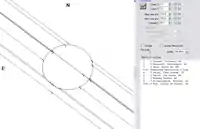13 Egeria
Egeria (minor planet designation: 13 Egeria) is a large main-belt G-type asteroid.[9] It was discovered by Annibale de Gasparis on November 2, 1850. Egeria was named by Urbain Le Verrier, whose computations led to the discovery of Neptune, after the mythological nymph Egeria of Aricia, Italy, the wife of Numa Pompilius, second king of Rome.[10]

%252C_deconvolved.pdf.jpg.webp) | |
| Discovery | |
|---|---|
| Discovered by | Annibale de Gasparis |
| Discovery site | Naples Obs. |
| Discovery date | 2 November 1850 |
| Designations | |
| (13) Egeria | |
| Pronunciation | /ɪˈdʒɪəriə/[1] |
Named after | Egeria |
| Main belt | |
| Adjectives | Egerian |
| Symbol | |
| Orbital characteristics[2] | |
| Epoch 13 January 2016 (JD 2457400.5) | |
| Uncertainty parameter 0 | |
| Observation arc | 60342 days (165.21 yr) |
| Aphelion | 2.7927 AU (417.78 Gm) |
| Perihelion | 2.36115 AU (353.223 Gm) |
| 2.57690 AU (385.499 Gm) | |
| Eccentricity | 0.083726 |
| 4.14 yr (1510.9 d) | |
Average orbital speed | 18.56 km/s |
| 261.863° | |
| 0° 14m 17.736s / day | |
| Inclination | 16.539° |
| 43.239° | |
| 80.294° | |
| Earth MOID | 1.43999 AU (215.419 Gm) |
| Jupiter MOID | 2.35966 AU (353.000 Gm) |
| TJupiter | 3.364 |
| Physical characteristics | |
| Dimensions | c/a = 0.76±0.06[3] 214.8×192[4] |
Mean diameter | 202±3 km[3] 207.6 ± 8.3 km (IRAS)[2] |
Mean radius | 103.82 ± 4.15 km |
| Mass | (9.2±2.1)×1018 kg[3] (15.9±4.4)×1018 kg[lower-alpha 1][5] |
Mean density | 2.13±0.49 g/cm3[3] 3.4±1.0 g/cm3[5] |
Equatorial surface gravity | ≈0.0580 m/s2 |
Equatorial escape velocity | ≈0.1098 km/s |
| 0.2935 d[6] (7.045 h)[2] | |
| 0.087[3] 0.0825 ± 0.007[2][7] | |
| Temperature | ~174 K |
| G-type asteroid[2] | |
| 9.71 to 12.46[8] | |
| 6.74[2] | |
Egeria occulted a star on January 8, 1992. Its disc was determined to be quite circular (217×196 km). On January 22, 2008, it occulted another star, and this occultation was timed by several observers in New Mexico and Arizona, coordinated by the IOTA Asteroid Occultation Program.[4] The result showed that Egeria presented an approximately circular profile to Earth of 214.8×192 km, well in agreement with the 1992 occultation. It has also been studied by radar.[11]
In 1988 a search for satellites or dust orbiting this asteroid was performed using the UH88 telescope at the Mauna Kea Observatories, but the effort came up empty.[12] Spectral analysis of Egeria shows it to be unusually high in water content, 10.5–11.5% water by mass.[13] This makes Egeria a prominent candidate for future water-mining ventures.
.png.webp)
See also
Notes
- (8.0 ± 2.2) × 10−12 M☉
References
- Noah Webster (1884) A Practical Dictionary of the English Language
- "JPL Small-Body Database Browser: 13 Egeria" (2008-11-04 last obs). Retrieved 8 April 2016.
- P. Vernazza et al. (2021) VLT/SPHERE imaging survey of the largest main-belt asteroids: Final results and synthesis. Astronomy & Astrophysics 54, A56
- Timerson, Brad. "IOTA Asteroid Occultation Results for 2008". Archived from the original on 16 April 2014. Retrieved 19 January 2010.
- James Baer, Steven Chesley & Robert Matson (2011) "Astrometric masses of 26 asteroids and observations on asteroid porosity." The Astronomical Journal, Volume 141, Number 5
- "Lightcurves and map data on numbered asteroids N° 1 to 52225". AstroSurf. Archived from the original on 27 November 2005. Retrieved 3 November 2008.
- "Asteroid Data Archive". Planetary Science Institute. Archived from the original on 23 May 2006. Retrieved 3 November 2008.
- apmag 9.71 (2061-Nov-06) to 12.46 (1990-Mar-12) JPL Horizons daily output for 1950 to 2099
- Rivkin, A. S.; J. K. Davies; S. L. Ellison; L. A. Lebofsky. "High-resolution 2.5–3.5 𝜇M Observations of C-, B- and G-class asteroids" (PDF). Retrieved 20 April 2008.
- Schmadel, Lutz D. (2003). Dictionary of minor planet names. Vol. 1 (5th ed.). Berlin Heidelberg New York: Springer-Verlag. p. 16. ISBN 3-540-00238-3.
- "Radar-Detected Asteroids and Comets". NASA/JPL Asteroid Radar Research. Retrieved 30 October 2011.
- Gradie, J.; Flynn, L. (March 1988), "A Search for Satellites and Dust Belts Around Asteroids: Negative Results", Abstracts of the Lunar and Planetary Science Conference, vol. 19, pp. 405–406, Bibcode:1988LPI....19..405G.
- Rivkin, A. S.; Davies, J. K. (2002). "Calculated water concentrations on C-class asteroids" (PDF). Lunar and Planetary Science (XXXIII).
External links
- "Elements and Ephemeris for (13) Egeria". Minor Planet Center. Archived from the original on 4 March 2016. Retrieved 26 May 2011. (displays Elong from Sun and V mag for 2011)
- 13 Egeria at AstDyS-2, Asteroids—Dynamic Site
- 13 Egeria at the JPL Small-Body Database